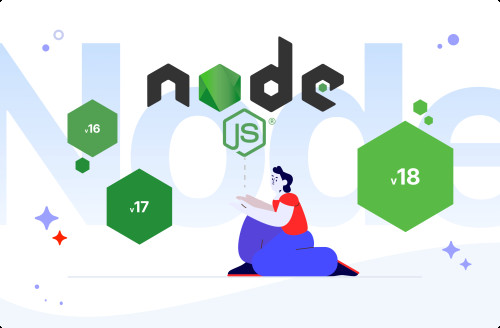Khởi tạo Node Js
Một dự án chạy bằng Node là có Express js. Qua bài https://expressjs.com/en/starter/generator.html thì chúng ta có thể tự động sinh ra cấu trúc dự án giống như trong cấu trúc sau:
.
├── app.js
├── bin
│ └── www
├── package.json
├── public
│ ├── images
│ ├── javascripts
│ └── stylesheets
│ └── style.css
├── routes
│ ├── index.js
│ └── users.js
└── views
├── error.pug
├── index.pug
└── layout.pug
Sau đó để chạy được dự án thì dựa vào file package.json thì để chạy cần dùng lệnh npm run start
Tích hợp socket io
Để cài đặt thì cần thêm thư viện Socket Io thì dùng lệnh trực tiếp là npm install socket.io tiếp đến để viết riêng 1 phần xử lý riêng phần socket ở trong file bin/www như sau
const io = require('socket.io')(3001, {
cors: {
origin: 'http://localhost:8000',
methods: ["GET", "POST"]
}
});
app.set('socketIO', io);
require('../app/controllers/socket')(io);
Khi khai báo như thế này thì sẽ là tạo ra port 3001 để dành cho socket và chỉ nhận request từ đường link http://localhost:8000 Và để có thể config được thông tin này thì có thể dùng env thông qua thư viện dotenv. Như vậy file www sẽ như sau:
#!/usr/bin/env node
/**
* Module dependencies.
*/
var app = require('../app');
var debug = require('debug')('chatnodejs:server');
var http = require('http');
require('dotenv').config();
/**
* Get port from environment and store in Express.
*/
var port = normalizePort(process.env.PORT || '3000');
var socketPort = normalizePort(process.env.SOCKETPORT || '3001');
var webUrl = process.env.WEBURL || 'http://localhost:8000';
app.set('port', port);
app.set('socketPort', socketPort);
app.set('webUrl', webUrl);
/**
* Create HTTP server.
*/
var server = http.createServer(app);
/**
* Socket IO
*/
const io = require('socket.io')(socketPort, {
cors: {
origin: webUrl,
methods: ["GET", "POST"]
}
});
app.set('socketIO', io);
require('../app/controllers/socket')(io);
/**
* Listen on provided port, on all network interfaces.
*/
server.listen(port);
server.on('error', onError);
server.on('listening', onListening);
/**
* Normalize a port into a number, string, or false.
*/
function normalizePort(val) {
var port = parseInt(val, 10);
if (isNaN(port)) {
// named pipe
return val;
}
if (port >= 0) {
// port number
return port;
}
return false;
}
/**
* Event listener for HTTP server "error" event.
*/
function onError(error) {
if (error.syscall !== 'listen') {
throw error;
}
var bind = typeof port === 'string'
? 'Pipe ' + port
: 'Port ' + port;
// handle specific listen errors with friendly messages
switch (error.code) {
case 'EACCES':
console.error(bind + ' requires elevated privileges');
process.exit(1);
break;
case 'EADDRINUSE':
console.error(bind + ' is already in use');
process.exit(1);
break;
default:
throw error;
}
}
/**
* Event listener for HTTP server "listening" event.
*/
function onListening() {
var addr = server.address();
var bind = typeof addr === 'string'
? 'pipe ' + addr
: 'port ' + addr.port;
debug('Listening on ' + bind);
}
Còn về file xử lý socket riêng viết như sau:
module.exports = function(io) {
io.on('connection', socket => {
socket.on('disconnect', async function() {
});
}
Xử lý bên client
Đầu tiên cần sử dụng socketio bên client thì có phần html để lấy list danh sách với input gửi message
<ul id="messages"></ul>
<form id="form" action="">
<input id="input" autocomplete="off" /><button>Send</button>
</form>
Tiếp đến khi load thư viện js socket như sau:
<script src="/socket.io/socket.io.js"></script>
<script>
var socket = io();
</script>
Tiếp đến bắt sự kiện khi submit form gửi message lúc đấy sẽ gửi lên socket theo sự kiện send_message
<script>
var socket = io();
var form = document.getElementById('form');
var input = document.getElementById('input');
form.addEventListener('submit', function(e) {
e.preventDefault();
if (input.value) {
socket.emit('send_message', input.value);
input.value = '';
}
});
</script>
Sau khi gửi message cần có sự kiện lấy danh sách message
socket.on('show_message', function(msg) {
var item = document.createElement('li');
item.textContent = msg;
messages.appendChild(item);
window.scrollTo(0, document.body.scrollHeight);
});
Như vậy toàn bộ file index.html như sau
<!DOCTYPE html>
<html>
<head>
<title>Socket.IO chat</title>
<style>
body { margin: 0; padding-bottom: 3rem; font-family: -apple-system, BlinkMacSystemFont, "Segoe UI", Roboto, Helvetica, Arial, sans-serif; }
#form { background: rgba(0, 0, 0, 0.15); padding: 0.25rem; position: fixed; bottom: 0; left: 0; right: 0; display: flex; height: 3rem; box-sizing: border-box; backdrop-filter: blur(10px); }
#input { border: none; padding: 0 1rem; flex-grow: 1; border-radius: 2rem; margin: 0.25rem; }
#input:focus { outline: none; }
#form > button { background: #333; border: none; padding: 0 1rem; margin: 0.25rem; border-radius: 3px; outline: none; color: #fff; }
#messages { list-style-type: none; margin: 0; padding: 0; }
#messages > li { padding: 0.5rem 1rem; }
#messages > li:nth-child(odd) { background: #efefef; }
</style>
</head>
<body>
<ul id="messages"></ul>
<form id="form" action="">
<input id="input" autocomplete="off" /><button>Send</button>
</form>
<script src="/socket.io/socket.io.js"></script>
var socket = io();
var messages = document.getElementById('messages');
var form = document.getElementById('form');
var input = document.getElementById('input');
form.addEventListener('submit', function(e) {
e.preventDefault();
if (input.value) {
socket.emit('chat message', input.value);
input.value = '';
}
});
socket.on('chat message', function(msg) {
var item = document.createElement('li');
item.textContent = msg;
messages.appendChild(item);
window.scrollTo(0, document.body.scrollHeight);
});
</body>
</html>



